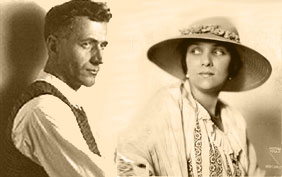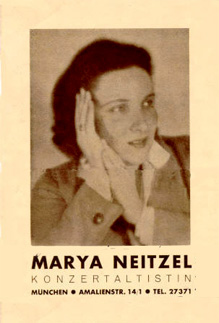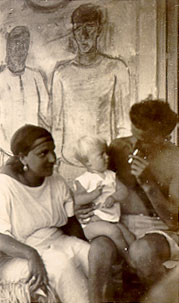|

|
|
Christian Hess and Marya Neitzel in 1925 |
They
met in the autumn of 1925 at a concert in Munich.
The spark which enflamed Hess’ emotions and left him
spellbound was struck by an aria from Gluck’s opera
Orfeo ed Euridice sung enchantingly by the warmly
expressive mezzosoprano Marya Neitzel. Transported
as she was by the singing, the intimate perfection
of music and poetry so typical of Gluck, Neitzel
instantly struck the artist’s sensibility. Hess was
also smitten by the singer’s undoubted beauty. It
was an extraordinary meeting between two artists who
liked each other at first sight.
Hess is so taken
that a few weeks later, in the middle of December,
he writes to his sister Emma in Messina to tell her
about the meeting with Neitzel. At that time in
Munich Hess is sharing an apartment-studio
with three artist friends (Florian Bosch, Sigfried
Kuhnel and Konig). The atelier is untidy and very
cold and Hess complains to Emma: “… I would like
to receive her in the best possible conditions,
inviting her to a place that is cleaner and more
agreeable. She is the widow of a state functionary
and has three lovely young boys. At the moment she
is working only occasionally as a singer as she is
without a regular contract. She is as tall as me -
and very pretty. She is now in Switzerland, from
where she writes me many letters. If I can earn
enough money to travel to Italy in the spring, she
will come with me - naturally paying her own way.
She gives me a hand for many things and she takes
great concern over me; no bad thing as I’m a
bachelor and disorganised artist.”
|
A concert
performer for Radio Munich |
|
  |
|
A brochure featuring the German
mezzosoprano Marya Janke-Neitzel, a
concert performer for Bayerische
Rundfunk, a renowned interpreter of
a vast repetoire ranging from lieder
by Beethoven, to cantatas by
Telemann and operas by Gluck (Orfeo
ed Euridice) and Richard Straus (Ariadne
auf Naxos). Among her teachers was
her brother in law Otto Neitzel, a
celebrated pianist, composer,
conductor and music critic. She
received plaudits for her
appearances at the Berlin Opera and
a series of recitals between the mid
1920’s and 1930’s in theatres and
concert halls across Germany,
Austria and Switzerland was greeted
with rapturous praise. (See
reviews).
She was also a serious student of
popular music and a talented author
of songs for the theatre. From her
collection “Zwei gedruckte
Notenhefte“ the composer Alfred von
Beckerath produced a highly
successful musical play for
children, "Der Schäferreigen", in
1962. |
At the
beginning of February 1926 Hess writes again
from Munich to his sister: “I am in the
new atelier at Schellingstrasse 46. It’s on
the fourth floor, is small and narrow but
comfortable and cheap.” Towards the end
of May he confesses: “The only reason I
stay on is my friend. She is singing at the
Berlin Opera and I hope she’ll be back to
Munich soon. I don’t think I’ll be able to
come to Sicily in the summer.” And on 26
July he writes to Emma: “I’m sitting in
the living-room of my friend’s house at
Amalienstrasse 14; I’ve moved in here. The
apartment is on the first floor. All the
walls are covered with my paintings,
water-colours, drawings and Models. It
is elegant and artistic here. Let’s hope
this marks the beginning of my ‘seven fat
years’.” On 21 August he sends a joyful
letter to his sister: “In the last few
weeks I decided to completely renovate my
friend’s house. It’s been repainted, there
are new carpets, everything’s been scrubbed
and polished.”
Hess is so happy
with Marya and gets on so well with her three
children, he feels the need to become an integral
part of the family. At the beginning of 1927 he
proposes marriage to Marya. She is flattered, but
feels unable to accept for financial reasons. If she
were to marry Hess, she would lose her widow’s war
pension and the allowance for her children. How
would it be possible to survive without the security
offered by this fixed income? They both know only
too well how difficult it can be first to sell a
painting and then how long actually it takes to
receive the money.
Hess is bitterly disappointed. He does not want to
be a burden and he also feels the need for a period
of reflection. He leaves for Sicily, but the
separation only makes his affection for Marya grow
stronger and he returns to Munich. In order to
contribute to the family budget he sells some of his
paintings in installments receiving 100 marks a
month.
|
 |
|
The Worthsee with the Zugspitze in the
background |
The sense of
family harmony grows; in the autumn of 1928 Hess
writes to Emma: “I’m with Marya and the boys at
Worthsee. The atmosphere here – the lake, the clouds
– is marvellous. I lounge in the back of the boat
and the boys row me round the lake. Not far away we
can see the Zugspitze; on the summit – around 3,000
meters – it’s two degrees below zero. All around is
the sweet smell of freshly mown grass. Right behind
the house is a wood full with hares, deer, foxes and
owls. Marya takes care of everything with such calm
joy: cooking, cleaning, making the beds, cooking
again - and all the time singing,” Marya added
to the letter: “We’re sitting on our verandah; we
can’t see the Straits [of Messina] but instead the
Worthsee which is heavenly too. With my four men to
look after I’ve got a mountain of work, but here in
the country everything’s easier – although there’s
not much sun.”At the beginning of 1930 Hess
writes from Munich to his sister: “At last I
received the money from the council for my painting.
I paid off some of my debts which left me with 10
marks.” Later that spring Hess was commissioned
to paint a series of frescoes at the spa in Bad
Oeynhausen near Hannover. The job would pay him
2,000 marks. On 4 October the artist writes to Emma:
“Dear sister, I sold the painting I told you
about in Switzerland for 1,000 marks to friends of
the patron and collector Karl Hofer. I’ll be paid in
installments.”
|
 |
|
Marya with Hess and his niece
Luisa in Messina, summer 1930 |
A few years later
Hess would be forced to leave Munich because of the
politica tension in the Bavarian capital. Already in
March 1931 he writes to Emma: “A few days ago we
staged a protest at a conference on modern art.
Hartmann and me were thrown out; two other
colleagues were beaten by the SA.” In subsequent
letters to his sister Hess adds: “… I’m very
involved in legal business and am called upon to be
a witness…” and “… the whole political
situation is extremely turbulent. You can’t even
open your mouth to say a word of common sense and
people think you want to enter politics. How I would
love to be in Sicily and hear none of this.”
In the summer of 1931 Hess’ paintings are among a
thousand works destroyed in a massive blaze at the
Glaspalast – a fire that later proved to be arson.
Then the Nazi regime orders the dissolution of the
Juryfreie movement which it accused of being a
Bolshevik organisation. The economic situation is
critical: “In Germany it’s now impossible to make
any kind of living by painting,” Hess writes to
his sister, “Send me some recipes and I’ll work
as a cook. Luckily I’ve got some friends abroad and
I sold two water-colours in Switzerland.”
In a letter dated 19 June 1932 Hess
writes to Emma: “All these continual decrees are
cutting seriously into Marya’s pension. The
children’s allowance stops when they’re 15, but
expenses just keep on rising. I sold a painting; we
spent a third of the money on food and the rest on
coal which we’ll need of course for the winter.”
Simply getting by is more and more difficult, not
least because of the unremitting ostracism towards
artists in the Juryfreie. Hess can stand the regime
no longer and wants to get out of Munich. On 17 July
1933 he sends a postcard to Emma: “I’ve just
bought a train ticket for Messina. It wasn’t cheap.
If I can get a visa, I’ll leave today or tomorrow.”
A week later Hess says goodbye to Marya and the boys
and moves to Sicily where he intends to stay a long
time.
The
birthday
collage
 In
the spring of 1934, when he was in exile in Messina,
Hess created a special collage for Marya’s birthday.
He folded it twice, popped it into an envelope and
sent it to Munich so that it would arrive in time
for 24 April – Marya’s 43rd birthday. The collage is
redolent of the couple’s memories of journies and
times spent together: springtime in Sicily – la
dolce vita – love – Marya’s orchestral concerts -
the Bach Gesellschaft – her performances on the
radio. Surrounding the outline of the cloth vase a
spray of faded petals and sprigs mostly made from
thin strips of newspaper covered with sweet
greetings for his beautiful German sweetheart whom
he calls by the pet name of ATA. At the bottom of
the page a flurry of greetings and best wishes from
Sig. Luigi (the painter’s Italianised nickname), his
sister Emma, his brother in law Guglielmo and his
nieces Luisa and Antonia. Thanks to the kind
permission of Frau Leonore Neitzel, in the summer of
2008 the collage was displayed as part of the major
retrospective of Hess’ work at the Rabalderhaus
Museum in Schwaz, the Austrian city where the
artist died in 1944. The same exhibition will be
held from November 2008 to January 2009 at the
Municipal Museum in Bolzano, the city where Hess was
born in 1895. 74 years after it was made the collage
has maintained all its special artistic character –
and its sheen of melancholy. In
the spring of 1934, when he was in exile in Messina,
Hess created a special collage for Marya’s birthday.
He folded it twice, popped it into an envelope and
sent it to Munich so that it would arrive in time
for 24 April – Marya’s 43rd birthday. The collage is
redolent of the couple’s memories of journies and
times spent together: springtime in Sicily – la
dolce vita – love – Marya’s orchestral concerts -
the Bach Gesellschaft – her performances on the
radio. Surrounding the outline of the cloth vase a
spray of faded petals and sprigs mostly made from
thin strips of newspaper covered with sweet
greetings for his beautiful German sweetheart whom
he calls by the pet name of ATA. At the bottom of
the page a flurry of greetings and best wishes from
Sig. Luigi (the painter’s Italianised nickname), his
sister Emma, his brother in law Guglielmo and his
nieces Luisa and Antonia. Thanks to the kind
permission of Frau Leonore Neitzel, in the summer of
2008 the collage was displayed as part of the major
retrospective of Hess’ work at the Rabalderhaus
Museum in Schwaz, the Austrian city where the
artist died in 1944. The same exhibition will be
held from November 2008 to January 2009 at the
Municipal Museum in Bolzano, the city where Hess was
born in 1895. 74 years after it was made the collage
has maintained all its special artistic character –
and its sheen of melancholy.
Marya’s
family decimated by two wars
Marya
was the daughter of Dr Lorenz Janke, a highly
regarded researcher in chemistry and botany
who headed the State Laboratory in Bremen.
Janke loved flowers and designed and tended
an alpine garden that was his pride and joy.
He died aged just 53 in 1906. Marya and her
younger sister Luise were sent by their
mother to the Meon Misail boarding school at
Neuchatel in Switzerland to finish their
education.
Right from childhood Marya
was blessed with a beautiful voice and in
Neuchatel she began singing lessons which
she was to continue in Bavaria. Marya grew
up in the Gauting district of Munich – the
Bavarian capital’s equivalent of Montmartre
– a quarter with a lively and varied
cultural life. She was artistic and
well-read, qualities appreciated by
Professor Walter Georg Neitzel whom she
married in 1913 and bore three sons. A
renowned jurist and diplomat, Neitzel was
fluent in several languages, lectured in
Roman law at Harvard University and acted as
government legal consultant for the German
community in China, a country he visited
several times. He was a high-ranking officer
in the Wermacht during the First World War
and was seriously wounded in fighting in the
forest of Argonne in north-eastern France.
He died of his injuries on 17 December 1918,
just over one month after the Armistice and
six months before the birth of his third
son. The two World Wars were to decimate
Marya’s family. The Great War left her a
widow with three children. She was forced to
abandon her home and move to the village of
Herrsching just outside Munich to stay with
her mother who helped her look after the
children. The Second World War proved even
crueller: all three of her sons saw combat;
two were killed, one - the eldest - survived
but only because he was wounded and sent
back from the front in the final stages of
the conflict.
|
Hess’ last letters |
Letter by Hess, dated 22 October 1944,
sent from Innsbruck to Marya in Munich
|
Hess’ last letter, dated 13 November 1944,
sent from Innsbruck to Marya in Munich.
|
Most likely one of the happiest periods in
Marya’s life was that between the autumn of
1925 and the summer of 1933 when her
friendship with Christian Hess wakened her
intellectual and sentimental affinities.
Once again there was a man in the house who
could spend time with the boys and could
offer paternal affection as they grew up. In
these eight years Marya accompanied Hess on
several of his trips to Italy and his stays
in Sicily. She became close to the painter’s
family and would exchange letters with his
sister Emma, brother in law Guglielmo and
the two nieces Luisa and Antonia, who called
her Aunt Maria.
And when Marya was on concert tours around
Europe Hess often went with her. In the
autumn of 1930 in Zurich Marya introduced
Hess to Cecile Faesy, who would later take
care of selling the artist’s work in
Switzerland. Marya could not have known that
her young friend would also become a rival
for Hess’ affections. When Hess abandoned
the political turmoil of Munich and sought
exile in Sicily, Cecile wrote frequently to
the painter. She was aware that Hess’
separation from Marya had led his feelings
for the singer to wane. Her letters to Hess
became more and more affectionate. Before
the artist moved to Messina he went to
Lucerne and met Cecile to collect some money
from paintings she had sold. She later
followed him to Sicily and on 20 August 1934
the couple were married. Just sixteen months
later, however, they split up. Divorce would
follow.
The bitterness of this brief interlude for
Marya and Hess was far overshadowed by the
tragic events of the war. The couple
resumed contact, exchanging letters marked
by firm friendship. Indeed, a few weeks
before Hess died from injuries received in
an allied air-raid on Innsbruck the last two
letters he ever wrote were to Marya. The
content was dominated by the war: the deaths
of common friends and acquaintances, Marya’s
concern for her son Walter, missing in
action. In one of the letters Hess includes
a sketch of himself in hospital – almost
certainly the last drawing he ever made. In
his final letter Hess recounts the air-raid
of 20 October 1944 and the anguish of being
abandoned among the rubble by a supposed
friend. In 2002 Hess’ last two letters were
donated to the Tirolerlandesmuseum
“Ferdinandeum” in Innsbruck by Frau Leonore
Neitzel, the widow of Wolfgang, Marya’s
first son and the only one of her children
who survived the war.
|